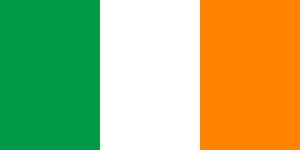
| Colors | HEX Code | RGB | CMYK |
|---|---|---|---|
| Green | #009A44 | 0, 154, 68 | 100, 0, 56, 40 |
| White | #FFFFFF | 255, 255, 255 | 0, 0, 0, 0 |
| Orange | #FF8200 | 255, 130, 0 | 0, 49, 100, 0 |
The green color in the Irish flag represents the Catholics and Irish republicanism dating back to the Society of United Irishmen in the 1790s and beyond. The orange color represents the protestants who are a minority that are part of independent Ireland. The white color in between symbolizes peace between them.
History of the Irish Flag
Ireland had different flags throughout its history. In the 13th century, it flew a blue flag with a golden harp. Many flags then represented Ireland until the modern flag with its three colors was first officially flown in the Easter Rising in 1916. However, it was known publicly long before that. Thomas Meagher, a leader of the Young Irelanders, flew the flag in Waterford city in 1848. It was flown all over Ireland together with the French tricolor to celebrate the French Revolution.
Inspired by the revolutions that were happening all around Europe and throwing emperors and kings from their thrones, the young Irish Leaders wanted to overthrow British rule in Ireland. Meagher introduced the flag in April 1848, explaining the white as a truce between the Green (Catholics), and the Orange (Protestants) who were deeply divided at that time. The rebellion leader was later sent to trial, but those who could escape established the Irish Republican Brotherhood that organized the Easter Rising in 1916, and raised the tricolor flag. Ireland led the War of Independence from 1919-1921 which ended with establishing the Ireland Free State recognized by the United Kingdom. The tricolor became the official flag of Ireland and was recognized in the Irish constitution in 1937.